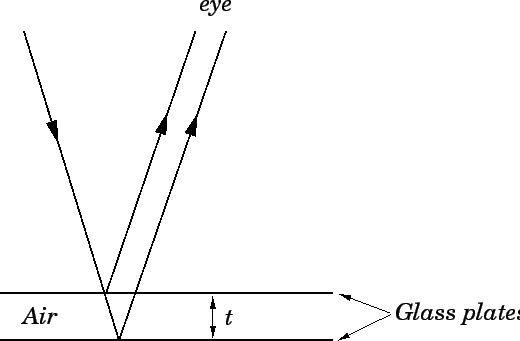 |
Suppose that a very thin film of air is trapped between two pieces of glass, as shown in Fig. 88. If monochromatic light (e.g., the yellow light from a sodium lamp) is incident almost normally to the film then some of the light is reflected from the interface between the bottom of the upper plate and the air, and some is reflected from the interface between the air and the top of the lower plate. The eye focuses these two parallel light beams at one spot on the retina. The two beams produce either destructive or constructive interference, depending on whether their path difference is equal to an odd or an even number of half-wavelengths, respectively.
Let ![]() be the thickness of the air film. The difference in path-lengths
between the two light rays shown in the figure is clearly
be the thickness of the air film. The difference in path-lengths
between the two light rays shown in the figure is clearly
![]() .
Naively, we might expect that constructive interference, and, hence,
brightness,
would occur if
.
Naively, we might expect that constructive interference, and, hence,
brightness,
would occur if
![]() , where
, where ![]() is an integer,
and destructive interference, and, hence, darkness, would occur if
is an integer,
and destructive interference, and, hence, darkness, would occur if
![]() . However, this is not the
entire picture, since an additional phase difference is introduced between
the two rays on reflection. The first ray is reflected at an interface
between an optically dense medium (glass), through which the
ray travels, and a less dense medium (air).
There is no phase change on reflection from such an interface, just
as there is no phase change when a wave on a string is reflected from a
free end of the string. (Both waves on strings and electromagnetic
waves are transverse waves, and, therefore, have analogous
properties.)
The second ray is reflected at an interface
between an optically less dense medium (air), through which the
ray travels, and a dense medium (glass). There is a
. However, this is not the
entire picture, since an additional phase difference is introduced between
the two rays on reflection. The first ray is reflected at an interface
between an optically dense medium (glass), through which the
ray travels, and a less dense medium (air).
There is no phase change on reflection from such an interface, just
as there is no phase change when a wave on a string is reflected from a
free end of the string. (Both waves on strings and electromagnetic
waves are transverse waves, and, therefore, have analogous
properties.)
The second ray is reflected at an interface
between an optically less dense medium (air), through which the
ray travels, and a dense medium (glass). There is a
![]() phase change on reflection from such an interface, just as
there is a
phase change on reflection from such an interface, just as
there is a ![]() phase change when a wave on a string
is reflected from a fixed end. Thus, an additional
phase change when a wave on a string
is reflected from a fixed end. Thus, an additional ![]() phase change
is introduced between the two rays, which is equivalent to an
additional path difference of
phase change
is introduced between the two rays, which is equivalent to an
additional path difference of ![]() . When this additional
phase change is taken into account, the condition for constructive
interference becomes
. When this additional
phase change is taken into account, the condition for constructive
interference becomes
| (377) |
| (378) |
For white light, the above criteria yield constructive interference for some wavelengths, and destructive interference for others. Thus, the light reflected back from the film exhibits those colours for which the constructive interference occurs.
If the thin film consists of water, oil, or some other transparent material
of refractive index ![]() then the results are basically the same as those for
an air film, except that the wavelength of the light in the
film is reduced from
then the results are basically the same as those for
an air film, except that the wavelength of the light in the
film is reduced from ![]() (the vacuum wavelength) to
(the vacuum wavelength) to ![]() .
It follows that the modified criteria for constructive and destructive
interference are
.
It follows that the modified criteria for constructive and destructive
interference are
| (379) |
| (380) |